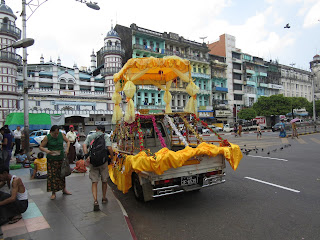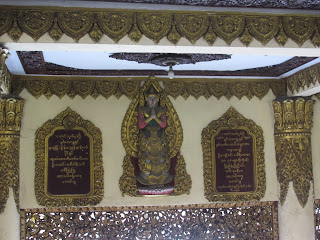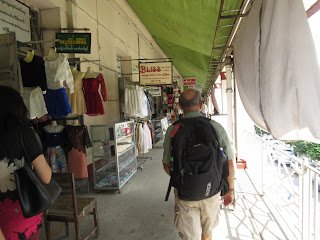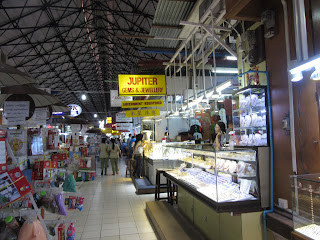My 'apologies' that there have been no blog posts for about 2 weeks. We just arrived here in Kuala Lumpur, Malaysia, yesterday after spending the last 2 weeks in Myanmar where we had basically no or extremely limited internet the entire time. We had so many wonderful experiences there and I hope to update you on as many as I can before we leave for Nepal in 2 days where I anticipate having limited access to wifi as well. I have close to 20 posts in my Drafts Folder which is rather daunting but please know I will get to them as time and internet allow. Annie on 11/29.
Last minute views of our hotel in Vientiane, Laos:
Communal relaxing and breakfast area.
We got a late afternoon flight from the Laos
capital of Vientiane to Myanmar ’s
capital city of Yangon .Many of you
may be more familiar with the country’s former name of Burma
and its capital city of Rangoon .
Built on the site of the ancient Mon city of Dagon
which is thought to have been built more than 2,000 years ago, it lies along
the Rangoon River Yangon (meaning ‘end of strife) by Ling Alaungpaya
following his conquest of the Mon kingdom
of Pegu Burma
by the British when Burma
was annexed as a crown colony.What an exciting time to visit Myanmar
as the country’s first free election had been held just days before our arrival and the prospect for real change was afoot.
We noticed immediately after hopping in a taxi at the
airport for the drive to our hotel, that there was a huge building boom going
on in Yangon . The drive took well over 50 minutes
through some of the slowest traffic jams I’d ever experienced.
View of the incomparable Schwedagon Pagoda en route to our hotel.
Wonder who we thought of when we saw this sign advertising a new upscale housing development!
Thankfully for
us but not so for the driver, the taxi fare was a flat rate based on
destination and not on the time it took to get there! We were very surprised to
see no motorcycles or scooters weaving in and out of traffic as we’d become
accustomed to in all the other Asian cities. We learned later that they are
banned in the capital region.
We got dropped off at the Royal Star Guesthouse which sounded so delightful but the name belied its actual appearance on a pretty rough looking street with the entrance up an extremely long and narrow set of stairs. Our room for the next three nights was up yet another very narrow flight of stairs. We didn’t mind that too much but having no hot water and internet for 3 nights got old quickly enough! We did though have our own bathroom which was a welcome change from our hotel in Vientiane.
As our hotel was located in the heart of the city, we
couldn’t wait to begin exploring downtown Yangon on foot when we got up on the 15th by following a walking tour I had copied from a travel guide. The influence of
the British former colonial masters was apparent in the city’s layout; the inner
city is organized like a chessboard and many of its Victorian buildings have
survived in varying states of preservation.
In Yangon , a wide variety of cultures
and religions mingle together and innumerable Buddhist pagodas stand side by
side with Hindu temples, mosques and churches. The city center could not
possibly be described as a peaceful serene place to visit. There was plenty of
hustle and bustle and a constant hubbub of loud voices, honking horns, and
street vendors offering their wares. We had to be mindful of every step we took
because of crumbling or nonexistent sidewalks and pay close attention for
difficult to find street signs to make sure we didn’t get lost or separated
from each other in the throngs of both pedestrian and vehicular traffic.
Myanmar writing! Lovely to look at but impossible for us to read.
Photos from our walking tour of Yangon :
Just a few minutes' walk from our hotel was this massive stone colonial structure with Burmese
ornamentation. It was the Yangon City Hall and was built by the British.
We stopped in at Immanuel
Baptist Church
Photos from Immanuel
Baptist Church
It sounded like we were back at Life Teen Mass at St. Frances Cabrini with a band
playing and young singers leading the Burmese and a few foreigners in the well
attended Sunday service. The church was originally built in 1830 though the
present building dates from 1885. I confess to being totally unaware of Baptist
missionaries spreading God’s word in Myanmar
or anywhere for that matter.
Monks coming up to us outside the church with their begging
bowls. We soon realized that begging was commonplace here in Yangon
as we were constantly approached by people, both young and old, asking for
handouts. We hadn’t experienced that at all so far this trip so it caught me at
least off guard.
View of Sule Pagoda in the heart of the city in the
middle of a roundabout. We were planning to stop there later so that view would
have to hold us for a while.
Photo of Mahabandoola
Garden Britain .
Normal attire for Burmese men all over the country.
A French bakery - of course we stopped!
The currency in Myanmar is kyat and is pronounced chat. The exchange rate was 10,000 kyat to .80 so the cost of the potato chicken bread above was .40.
Cutting up chives as I recall.
Walked next toward the Strand Hotel, ‘positively
dripping in opulent colonial-era luxury’ according to my travel notes.
Photos from Strand Hotel:
One of the more unusual souvenirs I've ever heard of that you could get within a month from the Strand Hotel was a custom carved and colored bust of yourself based on photos, etc you provide. I wonder how many people take them up on it!
I didn't know it when I took this photo our 1st morning in Yangon but sculptures of monks with their begging bowls is one of the most common souvenirs we saw all over the country.
We walked east for several blocks just inches from the cars
and trucks racing by us on the very busy Strand Road
It is said that when 8 Indian monks carried some relics of
the Buddha here more than 2,000 years ago, 1,000 military officers (botataung)
formed a guard of honor at the place where the rebuilt pagoda stands today. We
had to have our photos taken at the Foreign Ticket Office, below, before entering the
pagoda.
The pagoda's dimensions!
Above and for several photos below: Seeing the Buddha's Hair Relic.
We walked through one narrow gold covered/painted passageway after another before getting anywhere close to the Hair Relic. This place would not be high on the list of places for claustrophobics!
At last, the hair relic was somewhere in this display but the scrum of people behind us wanting to see it too prevented us from taking the time to try and find it because only 1 person could look through the looking glass at a time!
We had had enough of being cooped up inside so we then walked outside to explore the rest of the pagoda complex.
Runners to protect bare feet from the scorching hot
tiles.
Pouring (holy?) water repeatedly over the Buddha shrine.
Still at Botataung above and below: The Buddha's Tooth Relic Pagoda.
Interesting seeing people reading newspapers and lying down in
the pagodas.
After spending quite a bit of time wandering through much of Botataung Pagoda, we walked over to the Yangon River, located just behind it.
It was another hot day and we didn’t feel like braving the
heat and walking back through heavy traffic toward town so we took a taxi from
Botataung Pagoda to the Sule Pagoda that we’d glimpsed earlier. It was certainly
worth the 2,000 kyats or $1.60!
Customs House built in 1885.
Photos of Sule Pagoda:
No idea why the truck in front of the Sule Pagoda was so festively decorated.
For centuries Sule Pagoda has been the focus of much of the
social and religious activity of the city although much of the current
structure only dates from the nineteenth century. The British centered Yangon ’s
urban area around the pagoda when they structured their Victorian
street grid system in the mid nineteenth century. The 48m pagoda is still among the taller structures in the city center.
I'd say that about 90% of Burmese women wear these longyi, i.e. the type of skirt, based on my observations from our 2 weeks visiting much of Myanmar.
Women selling corn to feed the pigeons outside Sule Pagoda.
From the pagoda we walked through the city’s chaotic Indian Quarter down busy Mahabandoola Rd.
Before WWII, most of the city’s inhabitants were Indian or Chinese and their
influence is still reflected in this jam packed district.
I had never seen people in our travels paint their faces
with yellowish gold paint or powder, which is a very common practice particularly for women throughout
all of Myanmar .
I was very curious about it so looked into it online and found out the
following.
Thanaka is a yellowish-white cosmetics paste
made from ground bark and is commonly applied
to the face and sometimes the arms of women and girls, and is used to a lesser
extent also by men and boys. Thanaka trees are perennials,
and a tree must be at least 35 years old before it is considered mature enough
to yield good-quality cuttings. Thanaka in its natural state is sold as small
logs individually or in bundles, but it's also available as a paste or in
powder form.
Thanaka cream has been used by Burmese women for over 2000
years. It has a fragrant scent somewhat similar to sandalwood. The creamy paste is applied to the face normally in a circular patch on each
cheek. Apart from cosmetic beauty, thanaka also gives a cooling sensation and
provides protection from sunburn. It is believed to help remove acne and promote
smooth skin.
After wandering through the Indian Quarter, we detoured south a few blocks on 26th
St. in order to pay a visit to Moseah Yeshua
Synagogue.
Photos of Moseah Yeshua Synagogue:
It was closed because it was a Sunday but we talked with the
building’s long term custodian who suggested we return the next day. We learned
that there had been many Jewish owned businesses in Yangon
but they were nationalized by the Socialist government. Now only a handful of
Jewish families remain in Yangon .
Photos from Open Air Market on 26th
St
We didn't understand til we returned the next day why the produce was displayed in the center of the street like this. Just stay tuned to find out why!
Back in the Indian Quarter, we saw the Sri Kali
Hindu Temple.
We retraced our steps to Mahabandoola St. as we wanted to go to Bogyoke
Aung San Market, as it was billed as the largest and most interesting of Yangon ’s
bazaars.
On the way, we stopped in at the Anglican Holy Trinity Cathedral where a youth minister was leading the choir in singing ‘Alleluia.’
I had never seen this before but wished I had. Karen: I wonder if the religious education teachers at SFC might like this for their students.
As we left the cathedral, I wondered why barbed wire had been put up over its entrance.
We finally reached the Bogyoke Aung San Market where
we really enjoyed strolling through it seeing Burmese handicrafts, a wide
variety of gorgeous textiles, woodcarvings, lacquerware, etc. Nearly the entire first floor was taken up by jewelers selling gorgeous Burmese rubies. No, I didn't want or need any!
Above: Our hotel. Below: The staircase to the street from the reception area.
Not easy lugging our duffle bags up these stairs but we did have help luckily!
Then, in case we hadn't climbed enough stairs, we had more to climb from the small reception area to the second floor where our room was. Unfortunately hot water for tea was down these narrow stairs so, needless to say, I didn't have much tea while we stayed at the Royal Star Hotel!
Posted on 11/29 from Kuala Lumpur, Malaysia.














































































































No comments:
Post a Comment
We love to hear your comments!